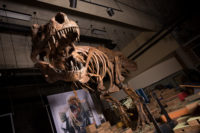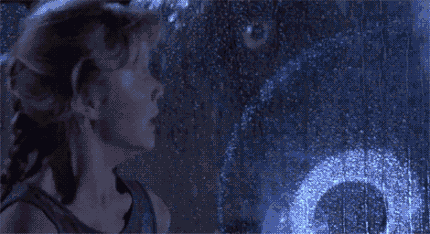 A study by University of Alberta paleontologists has confirmed that the fossil of a Tyrannosaurus rex found in Saskatchewan is the largest known T. rex specimen in the world.
A study by University of Alberta paleontologists has confirmed that the fossil of a Tyrannosaurus rex found in Saskatchewan is the largest known T. rex specimen in the world.
The first piece of the 66-million-year-old giant was discovered on August 16th, 1991, by Eastend high school teacher Robert Gebhardt who was learning how to find fossils in the field with a team of University of Alberta paleontologists. In the exposed bedrock along Saskatchewan’s Frenchman River Valley, Gebhardt discovered the base of a teeth a tail vertebra. Their size and shape indicated they were from a Tyrannosaurus rex. That night the team celebrated the find with a bottle of Scotch and named the dinosaur after their celebratory tipple.
Getting him out of the rock would take another two decades of painstaking work by paleontologists, students and volunteers. Excavations began in June of 1994, each fossilized bone chipped out of the bedrock by hand one at a time. By the time the last bone had been recovered, it was 2014 and it was clear that not only had they found the Saskatchewan’s first T. rex, but that Scotty was a splendid example.
Approximately 65% of the skeleton was found and puzzled together over years. The reconstructed skeleton indicates Scotty was 43 feet long and weighed around 19,400 pound making him the largest known T. rex ever found. He was also the longest-lived.
“Scotty is the oldest T. rex known,” [U of A paleontologist Scott] Persons explained. “By which I mean, it would have had the most candles on its last birthday cake. You can get an idea of how old a dinosaur is by cutting into its bones and studying its growth patterns. Scotty is all old growth.”
But age is relative, and T. rexes grew fast and died young. Scotty was estimated to have been in its early 30s when it died.
“By Tyrannosaurus standards, it had an unusually long life. And it was a violent one,” Persons said. “Riddled across the skeleton are pathologies — spots where scarred bone records large injuries.”
Among Scotty’s injuries are broken ribs, an infected jaw and what may be a bite from another T. rex on its tail—battle scars from a long life.
Scotty will go on public view at the Royal Saskatchewan Museum this May. The museum has been working assiduously to create a new exhibition space that will do the massive creature justice. The RSM is doing a full renovation and redesign of its upper and lower gallery entrances that will give visitors the opportunity to view Scotty from two perspectives, foot level and eye level. The upper level isn’t just a catwalk or perch, but rather a fully functional second tier that can be used to host events supervised by the unblinking gaze of a T. rex’s eye (socket).

It might be an orbit to you, but it’s a socket to me.
A couple of years ago, I had the opportunity to see one of those larger skeletons, and it was -even extinct- rather intimidating.
If I understood the issue correctly, the big ones were mostly female. One of the smallest specimens, however, is probably this baby Tyrannosaurus rex.
A few more years ago, I was entertaining a whole team of female ‘universe frisbeeing’ “Squirrels” from the UK, and a relative of one of them had just discovered one of the first juvenile ‘T-reges’ in -as far as I remember- Montana. The big news had apparently been that it was not a new species but a juvenile Tyrannosaurus.
Check out how frightening even a nesting (male, in this case) cassowary can be, imagine it at least a hundred times as big with shark teeth ..and kiss your ass goodbye :skull: – Itself, it might taste like chicken, though.
Capturing the past, unlocks the door to the future.